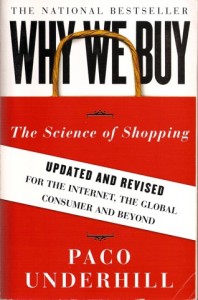The one-sentence summary
Small changes to the shopping experience can make a huge difference to sales.
- There is a science of shopping. It can be understood by intense scrutiny of how people behave in the retail environment.
- The mechanics of shopping shows, among other things, that there is a twilight zone in the entrance of stores that people go straight past; that having two hands restricts their options; that they have real trouble reading signs; that they move in certain clearly defined ways; and that they shift around all the time.
- Understanding these dynamics and making small changes can lead to massive increases in sales and profits.
- People want to see, feel and touch most items they might buy, and yet many store designs, and a lot of packaging, prevents them from doing so. These sensory elements are often ignored in the shopping process.
- Shopping is defined as experiencing that portion of the world that has been deemed for sale – it is an activity in its own right, not just the acquisition of necessities.
- The confusion index measures how baffled shoppers are, and the interception rate measures how often they interact with staff.
- The butt-brush factor determines how closely packed merchandise is – women in particular hate it when people squeeze past them.
WHAT’S GOOD ABOUT IT
- Shoppers love touch, mirrors, discovery, talking, recognition and bargains
- Shoppers dislike too many mirrors, having to ask dumb questions, dipping down to pick things up, goods out of stock, obscure price tags and intimidating service.
- Examples of small tweaks and details in the retail environment include:
– The CEO who thought his conversion rate was perfect, only to find it was 48%
– Store owners who think people spend 10 minutes in store, when in fact it is 2
– Giving people a basket when their hands are full means they will buy more
– 65% of men who try something on buy it, but only 25% of women
– The dressing room is the most important room in a store, but has the least investment
– Waiting time can be ‘bent’ by human interaction, orderliness of queuing, companionship and diversion – these make people wait longer more happily
WHAT YOU HAVE TO WATCH
- It is perhaps not surprisingly hugely in favour of shopping, and not everyone will agree with this.
- The author is not a fan of online shopping, and says so at some length.

